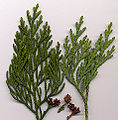Thuja standishii
| Thuja standishii subsp. var. | Japanese arborvitae | |||||||||||||||||||||||||||||||||||||||||||||||||||||||
|---|---|---|---|---|---|---|---|---|---|---|---|---|---|---|---|---|---|---|---|---|---|---|---|---|---|---|---|---|---|---|---|---|---|---|---|---|---|---|---|---|---|---|---|---|---|---|---|---|---|---|---|---|---|---|---|---|

|
|
| ||||||||||||||||||||||||||||||||||||||||||||||||||||||
| ||||||||||||||||||||||||||||||||||||||||||||||||||||||||
Thuja standishii (Japanese Thuja; Template:Lang-ja) is a species of thuja, an evergreen coniferous tree in the cypress family Cupressaceae. It is native to southern Japan, where it occurs on the islands of Honshū and Shikoku. It is a medium-sized tree, reaching 20-35 m tall and with a trunk up to 1 m diameter.
The foliage forms in flat sprays with scale-like leaves 2-4 mm long, matte green above, and with narrow white stomatal bands below. The cones are oval, yellow-green ripening red-brown, 6-12 mm long and 4-5 mm broad (opening to 8 mm broad), with 6-10 overlapping scales.
| Standard Cyclopedia of Horticulture |
|---|
|
Thuja standishii, Carr. (T. japonica, Maxim. T. gigantea, var. japonica, Franch. & Sav. Thujopsis Standishii, Gord.). Similar to the preceding but lower, usually only 20-30 ft. high: branchlets more irregularly set, thicker and less compressed: lvs. of vigorous shoots closely placed together, ending in short rigid points spreading outward, of the lateral branchlets ovate, obtusish, thickish, lighter green above, darker beneath and with whitish, triangular spots, without gland: cones oval, little over 1/3 in. long; scales 8, oval, usually the 2 middle pairs fertile. Japan. CH
|
Cultivation
- Do you have cultivation info on this plant? Edit this section!
Propagation
- Do you have propagation info on this plant? Edit this section!
Pests and diseases
- Do you have pest and disease info on this plant? Edit this section!
Species
Gallery
If you have a photo of this plant, please upload it! Plus, there may be other photos available for you to add.
-
photo 1
-
photo 2
-
photo 3
References
- Standard Cyclopedia of Horticulture, by L. H. Bailey, MacMillan Co., 1963
External links
- w:Thuja standishii. Some of the material on this page may be from Wikipedia, under the Creative Commons license.
- Thuja standishii QR Code (Size 50, 100, 200, 500)

